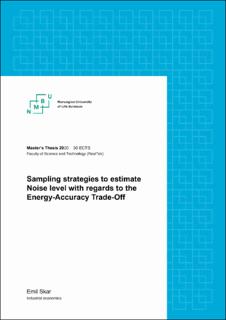| dc.contributor.advisor | Liland, Kristian Hovde | |
| dc.contributor.advisor | Tomic, Oliver | |
| dc.contributor.advisor | Nordby, Jon | |
| dc.contributor.author | Skar, Emil | |
| dc.date.accessioned | 2021-01-12T16:52:14Z | |
| dc.date.available | 2021-01-12T16:52:14Z | |
| dc.date.issued | 2020 | |
| dc.identifier.uri | https://hdl.handle.net/11250/2722651 | |
| dc.description.abstract | Noise is a growing problem in today's society. This is especially true in urban areas, where noise pollution has become an important factor in the deteriorating health of the residents. Due to this, several regulations have been implemented by different governmental bodies. One of these is EU's directive 2002/49/ec, which says that noise maps must be created for specific areas that are especially noise heavy. These noise maps are created through simulations and have been shown to be imprecise and also dependent on good data sources, something which is scarce. Innovations look at noise monitoring through wireless communication systems to counteract these problems, but they are mostly dependent on either a cable grid for energy supply or a secondary energy source.
Most of the noise indicators used today are cumulative of nature, and thus a continuous data stream is not of necessity. Therefore, a thought is to introduce a sampling strategy to the wireless sensors. A sampling strategy decides when to measure sound and when not to, and may lessen energy usage.
A dataset containing continuous measurements over 11 weeks of a student working environment at NTNU is used to evaluate different sampling strategies. The dataset consists of data collected from five sensors. The data was preprocessed and a master sensor chosen. The rest of the sensors' data was utilized to impute the missing values of the master sensor. The time interval of noise measurements was chosen to be 15 minutes.
Three algorithms; a Dummy Regression, a Linear Regression and a Random Forest Regression were trained and evaluated. The target variable was the RMSE between the $L_{Aeq,15min}$ containing all measurements and the $L_{Aeq,15min}$ containing only the subsampled measurements.
The models' performance was put in the context of the economic benefits that a lower energy usage may give. A Pareto-front was used to find the optimum, and it was concluded that a subsampling rate of 65 \% was optimal for the student working space. A cost-benefit analysis was done on four different sensor network alternatives consisting of 22 sensors, and the best scoring alternative was the one that implemented the subsampling rate that NTNU SOA recommended. | en_US |
| dc.description.abstract | Støy er et økende problem i dagens samfunn. Dette gjelder spesielt for urbane områder, der støyforurensning har blitt en viktig faktor i den svekkede helsen til innbyggerne. På grunn av dette er flere forskrifter blitt lagt frem av forskjellige statlige organer. Et av disse er EUs direktiv 2002/49 / ec, som sier at det må lages støykart for spesifikke områder som er spesielt støytunge. Disse støykartene er laget gjennom simuleringer og har vist seg å være upresise og også avhengige av gode datakilder, noe som er mangelvare i dag. Innovasjoner ser på støyovervåking gjennom trådløse kommunikasjonssystemer for å motvirke disse problemene, men de er stort sett avhengig av enten et kabelnett for energiforsyning eller en sekundær energikilde. | en_US |
| dc.language.iso | eng | en_US |
| dc.publisher | Norwegian University of Life Sciences, Ås | en_US |
| dc.rights | Attribution-NonCommercial-NoDerivatives 4.0 Internasjonal | * |
| dc.rights.uri | http://creativecommons.org/licenses/by-nc-nd/4.0/deed.no | * |
| dc.title | Sampling strategies to estimate Noise level with regards to the Energy-Accuracy Trade-Off | en_US |
| dc.type | Master thesis | en_US |
| dc.source.pagenumber | 102 | en_US |
| dc.description.localcode | M-DV | en_US |

